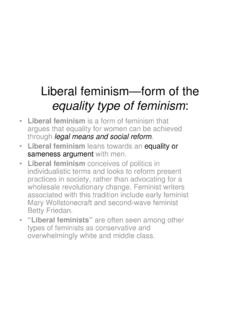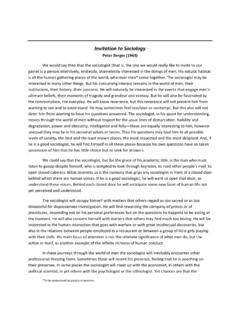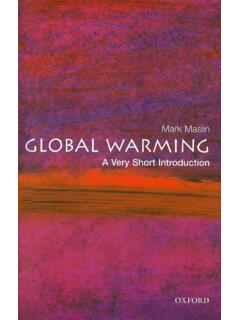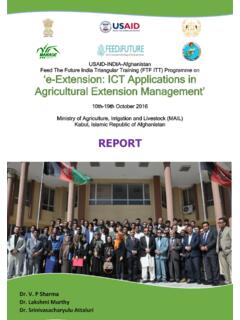Transcription of Article 4
1 1 Article 4 Who Rules America?G. William DomhoffPower and Class in the United StatesPower and class are terms that make Americans a little uneasy,and concepts like power elite and dominant class immediatelyput people on guard. The idea that a relatively fixed group ofprivileged people might shape the economy and governmentfor their own benefit goes against the American grain. Never-theless,.. the owners and top-level managers in large income-producing properties are far and away the dominant power fig-ures in the United States. Their corporations, banks, and agri-businesses come together as a corporate community thatdominates the federal government in Washington. Their real es-tate, construction, and land development companies formgrowth coalitions that dominate most local , there is competition within both the corporate commu-nity and the local growth coalitions for profits and investmentopportunities, and there are sometimes tensions between na-tional corporations and local growth coalitions, but both are co-hesive on policy issues affecting their general welfare, and inthe face of demands by organized workers, liberals, environ-mentalists, and a result of their ability to organize and defend their inter-ests, the owners and managers of large income-producing prop-erties have a very great share of all income and wealth in theUnited States.
2 Greater than in any other industrial up at best 1 percent of the total population, by the early1990s they earned percent of the nation s yearly incomeand owned percent of all privately held wealth, percent of all corporate stocks and percent of allbonds. Due to their wealth and the lifestyle it makes possible,these owners and managers draw closer as a common socialgroup. They belong to the same exclusive social clubs, frequentthe same summer and winter resorts, and send their children toa relative handful of private schools. Members of the corporatecommunity thereby become a corporate rich who create a na-tionwide social upper class through their social of the growth coalitions, on the other hand, are placeentrepreneurs, people who sell locations and buildings.
3 Theycome together as local upper classes in their respective citiesand sometimes mingle with the corporate rich in educational orresort corporate rich and the growth entrepreneurs supplementtheir small numbers by developing and directing a wide varietyof nonprofit organizations, the most important of which are a setof tax-free charitable foundations, think tanks, and policy-dis-cussion groups. These specialized nonprofit groups constitute apolicy-formation network at the national level. Chambers ofcommerce and policy groups affiliated with them form similarpolicy-formation networks at the local level, aided by a few na-tional-level city development organizations that are availablefor local corporate owners who have the interest and ability totake part in general governance join with top-level executives inthe corporate community and the policy-formation network toform the power elite, which is the leadership group for the cor-porate rich as a whole.
4 The concept of a power elite makes clearthat not all members of the upper class are involved in gover-nance; some of them simply enjoy the lifestyle that their greatwealth affords them. At the same time, the focus on a leadershipgroup allows for the fact that not all those in the power elite aremembers of the upper class; many of them are high-level em-ployees in profit and nonprofit organizations controlled by thecorporate power elite is not united on all issues because it includesboth moderate conservatives and ultraconservatives. Althoughboth factions favor minimal reliance on government on all do-mestic issues, the moderate conservatives sometimes agree tolegislation advocated by liberal elements of the society, espe-cially in times of social upheaval like the Great Depression ofthe 1930s and the Civil Rights Movement of the early on defense spending, ultraconservatives are character-ized by a complete distaste for any kind of government pro-grams under any circumstances even to the point of opposinggovernment support for corporations on some issues.
5 Moderateconservatives often favor foreign aid, working through theUnited Nations, and making attempts to win over foreign ene-mies through patient diplomacy, treaties, and trade , ultraconservatives have opposed most forms ofANNUAL EDITIONS2foreign involvement, although they have become more tolerantof foreign trade agreements over the past thirty or forty the same time, their hostility to the United Nations of the power elite enter into the electoral arena asthe leaders within a corporate-conservative coalition, wherethey are aided by a wide variety of patriotic, antitax, and othersingle-issue organizations. These conservative advocacy orga-nizations are funded in varying degrees by the corporate rich,direct-mail appeals, and middle-class conservatives.
6 This coali-tion has played a large role in both political parties at the presi-dential level and usually succeeds in electing a conservativemajority to both houses of Congress. Historically, the conserva-tive majority in Congress was made up of most Northern Re-publicans and most Southern Democrats, but that arrangementhas been changing gradually since the 1960s as the conservativeDemocrats of the South are replaced by even more conservativeSouthern Republicans. The corporate-conservative coalitionalso has access to the federal government in Washingtonthrough lobbying and the appointment of its members to top po-sitions in the executive their preponderant power within the federal govern-ment and the many useful policies it carries out for them, mem-bers of the power elite are constantly critical of government asan alleged enemy of freedom and economic growth.
7 Althoughtheir wariness toward government is expressed in terms of a dis-like for taxes and government regulations, I believe their under-lying concern is that government could change the powerrelations in the private sphere by aiding average Americansthrough a number of different avenues: (1) creating governmentjobs for the unemployed; (2) making health, unemployment,and welfare benefits more generous; (3) helping employeesgain greater workplace rights and protections; and (4) helpingworkers organize unions. All of these initiatives are opposed bymembers of the power elite because they would increase wagesand taxes, but the deepest opposition is toward any governmentsupport for unions because unions are a potential organizationalbase for advocating the whole range of issues opposed by thecorporate Does Democracy Fit In?
8 [T]o claim that the corporate rich have enough power to beconsidered a dominant class does not imply that lower socialclasses are totally powerless. Domination means the power toset the terms under which other groups and classes must op-erate, not total control. Highly trained professionals with an in-terest in environmental and consumer issues have been able tocouple their technical information and their understanding ofthe legislative and judicial processes with well-timed publicity,lobbying, and lawsuits to win governmental restrictions onsome corporate practices. Wage and salary employees, whenthey are organized into unions and have the right to strike, havebeen able to gain pay increases, shorter hours, better workingconditions, and social benefits such as health insurance.
9 Eventhe most powerless of people the very poor and those discrim-inated against sometimes develop the capacity to influencethe power structure through sit-ins, demonstrations, socialmovements, and other forms of social disruption, and there isevidence that such activities do bring about some redress ofgrievances, at least for a short generally, the various challengers to the power elitesometimes work together on policy issues as a liberal-labor co-alition that is based in unions, local environmental organiza-tions, some minority group communities, university and artscommunities, liberal churches, and small newspapers and mag-azines. Despite a decline in membership over the past twentyyears, unions are the largest and best-financed part of the coali-tion, and the largest organized social force in the country (asidefrom churches).
10 They also cut across racial and ethnic lines morethan any other institutionalized sector of American policy conflicts between the corporate-conservative andliberal-labor coalitions are best described as class conflicts be-cause they primarily concern the distribution of profits andwages, the rate and progressivity of taxation, the usefulness oflabor unions, and the degree to which business should be regu-lated by government. The liberal-labor coalition wants corpora-tions to pay higher wages to employees and higher taxes togovernment. It wants government to regulate a wide range ofbusiness practices, including many that are related to the envi-ronment, and help employees to organize unions. The corpo-rate-conservative coalition resists all these policy objectives toa greater or lesser degree, claiming they endanger the freedomof individuals and the efficient workings of the economic mar-ketplace.


![C. Wright Mills, “The Promise [of Sociology]” Excerpt from ...](/cache/preview/8/8/d/3/7/4/6/d/thumb-88d3746d47f35190a688235dffb515cf.jpg)






